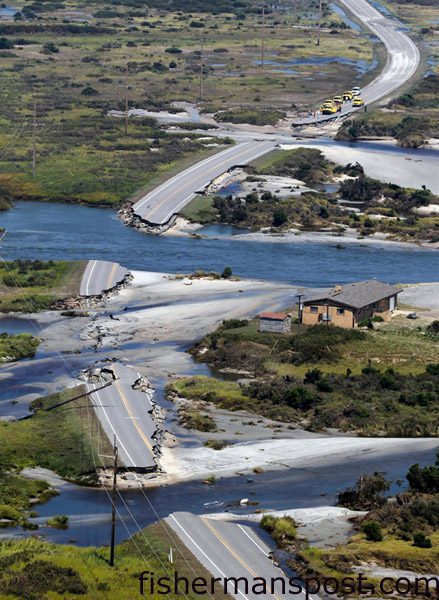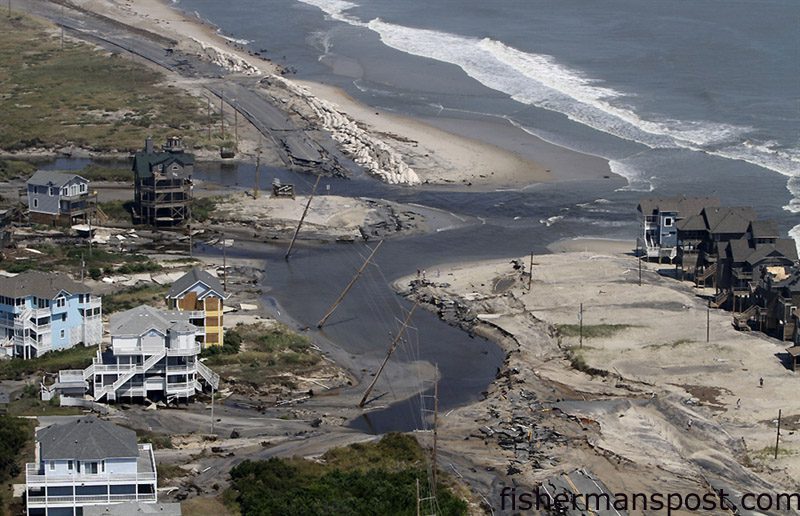Hatteras September 1, 2011

The group of washouts near Pea Island with the cut extending to the sound visible in the middle of the photo. This is the larger of the breaches of NC 12 left after Hurricane Irene’s passage cut Hatteras Island off from the mainland.
Hatteras Island bore the brunt of Hurricane Irene’s impacts to NC’s Outer Banks. No village on the island was left untouched, but the northern beach villages of Avon, Salvo, Rodanthe, and Waves took Irene on the chin. A one-two punch of strong east winds and punishing surf and massive soundside flooding after the storm had moved to the north conspired to leave many structures in the northern villages damaged or destroyed and the entire island cut off from the outside world.
NC Hwy. 12, the island’s sole connection to the mainland, was breached by the Atlantic Ocean in multiple spots between Hatteras Village and Pea Island. Most of the breaches only led to a sand-covered road after the storm was gone, but a pair of them washed out the road and established new connections between the ocean and Pamlico Sound.
Just north of Rodanthe, at the “S-Curves” section of NC 12, water is still flowing between the ocean and sound through one section and has undermined the road in several nearby spots.
A larger breach exists in Pea Island National Wildlife Refuge, one that’s been estimated at half the size of the 1,700’ “Isabel Inlet” formed in 2003 between the villages of Frisco and Hatteras. The Pea Island breach is said to be around 6’ deep, and is conducting no insubstantial amount of water between ocean and sound.
At present, a pair of daily ferries from Stumpy Point on the Pamlico Sound to Rodanthe and Hatteras Village are supplying islanders with food, water, medical supplies, and other necessities, but otherwise, those who rode out the storm on the island are cut off.
Several large generators are providing power to much of the affected area, but due to the limited power, food, water, and other supplies, not even all the island residents who evacuated have been allowed back to their homes, and it will be some time before the islands have the necessary infrastructure for tourists and anglers to visit.
Likely, NC 12 will have to be repaired before that can happen, and that’s going to take some time while several differing plans for the rebuilding of the road are debated and enacted. Temporary bridges over the breaches, permanent bridges, filling and repaving the areas, and a longer, 17.5 mile bridge from Oregon Inlet to Rodanthe have all been pitched, but there’s no consensus yet as to what will take place, as a myriad of different groups including state and federal government agencies, locals, and environmental groups are vying for their preferred solutions.

The breach of the roadway at the “S-Curves” section of Highway 12 just north of Rodanthe. Both sections of road will have to be repaired through filling and repaving, bridging, or bypassed in order to restablish the only roadway linking the majority of Cape Hatteras National Seashore to the state of North Carolina.
In the meantime, anglers with plans of visiting Hatteras in the coming weeks should make other arrangements, as it will be at least four weeks on the low end before everything’s in order for visitors.
As of press time, Ocracoke Island, which escaped much of the storm’s wrath, is still without power and closed to visitors, but it will likely open back up before Hatteras does.
Everyone on Hatteras and Ocracoke shares one loss from Irene, as their tourist season had its doors slammed shut by mandatory evacuation a week before one of their biggest weekends of the year and at a time when many begin socking funds away for the lean winter. Without Labor Day weekend and the following fall fishing season, virtually all of the islands’ businesses and residents will be living a little leaner this winter.
Reached by phone just before publication deadline, Kyle Perry of Frisco, NC’s Frisco Rod and Gun, urged the public to do what they can for Hatteras Island’s northern villages.
“We got through okay down here and were open the morning after the storm,” he explained. “There was 10’ of water on the highway in some spots up there. There are people in shelters whose houses flooded or were torn up. A lot of the oceanfront houses took damage from the east wind and surf, too, so it wasn’t just the flooding.”
Perry recommends anyone who’d like to donate time or money to those in need on the island call (252) 475-5758 or (252) 475-5759 to coordinate the most effective way of doing so.
On the positive side, no major injuries have been reported on Hatteras or Ocracoke as a result of Irene, and the residents of the Outer Banks are some of the most resilient people around and used to dealing with storms. They will rebuild and restore their villages, and when practical, people will be able to access arguably the finest beach and fishing grounds in the state.
When that time comes, they’ll need all the visitors and anglers they can get to make up for losing this last part of their summer incomes, and everyone who can should make it a point to see these beautiful beaches, wet a line in the surf, take an inshore or offshore charter, or just show up and enjoy what makes these islands unique and wonderful—the same fragile connection to the vast force and beauty of the Atlantic Ocean that makes storms and recovery from them an inevitability.
